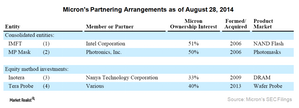An Instructive Rundown of Micron’s Business Strategies
Two business strategies that Micron can use to beat competition include innovating processes that reduce costs and developing next-generation products.
Nov. 20 2020, Updated 3:32 p.m. ET

Nature of business
Micron Technology (MU) operates in the highly unpredictable semiconductor world, an industry governed by high fixed costs—one-time costs of building plants or R&D (research and development)—and low-variable costs, such as raw materials and other daily expenses. The memory industry, in particular, is highly sensitive to chip prices, market demand for the semiconductor products, and efficient uses of fabrication plants.
Risks in memory chip production
Micron’s memory chip products are commodities, which means chips of different suppliers are functionally identical. This exposes Micron to price wars with South Korean (EWY) competitors like Samsung Electronics (SSNLF) and SK Hynix, as customers are not biased towards one supplier.
The two biggest ways a company like Micron can stand above the competition include:
- innovating processes that can reduce costs
- developing next-generation products
Micron’s business strategies
In the last few years, the company has resorted to strategic acquisitions and partnerships to scale up its capacity by over 90% and diversify its product portfolio. For example, after the company completed the acquisition of Japan’s Elpida and Rexchip, Micron’s manufacturing capacity almost doubled, making it one of the top five fastest growing Fortune 500 companies in 2015.
Strategic partnerships
Micron partners with various companies to develop advanced products and processes at lower costs. Partnerships allow the company to share R&D costs. Perhaps most notably, the company has partnered with Intel Corporation (INTC) to design, develop, and manufacture NAND Flash and other innovative memory products. NAND flash is a type of non-volatile memory chip that can retain data even when the power is off. The partnership recently developed a breakthrough memory product 3D XPoint for big data applications. 3D XPoint is believed to be 1,000 times faster than NAND flash memory.
Micron has also partnered with Photronics (PLAB) to produce photomasks for advanced semiconductors and with Nanya Technology Corporation to produce DRAM (dynamic random access memory), a type of memory that provides high-speed data storage and retrieval. Photomasks are glass substrates coated with an opaque film, on which the semiconductor’s design is etched.
The PowerShares QQQ Trust, Series 1 (QQQ) has 0.34% exposure in Micron Technology. Read the next part of this series for a look at how companies like Micron are dependent on DRAM prices.
